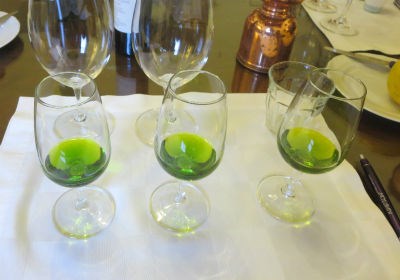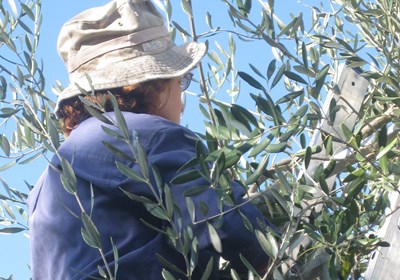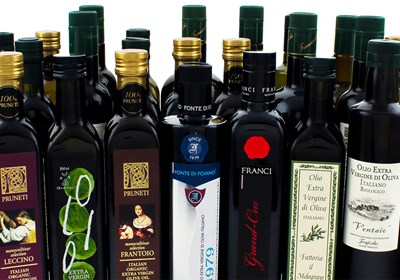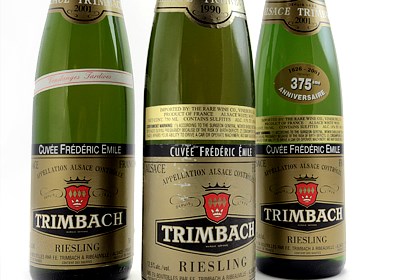
Which site would you like to visit?
By clicking the retail or wholesale site button and/or using rarewineco.com you are choosing to accept our use of cookies to provide you the best possible web experience.
Looking for currently available olive oils? Click to Jump to the List
A great olive oil is one of Mother Nature’s most remarkable gifts—the essence of the olive, bursting with its own constellation of flavors and aromas, yet capable of marrying with a vast diversity of foods. And in our view, and the view of many, the world’s greatest olive oils come from Tuscany.
Our awakening to the glories of great Tuscan oil came in the mid-1980’s, when we had dinner one April night at the venerable Montalcino estate, Il Poggione.
They were rightly proud of their extra virgin olive oil, encouraging us to pour it on every dish short of dessert. It was exhilarating. We dipped and drizzled with abandon: over the thick Tuscan soup; on fennel bulbs; over the grilled meat, and on thick slices of toasted bread rubbed with garlic cloves.
What we didn’t realize at the time was that we were enjoying a precious commodity, as great Tuscan oil can only be made from tiny yields, and by harvesting early. A tree in the hills near Florence—harvested in November—may yield only a liter of olive oil. Compare this to the commercially farmed trees along Tuscany’s coast—harvested much later—which produce 20+ liters of oil per tree.
After our experience at Il Poggione, we were shocked to discover just how difficult it was to find comparable oils in the United States. Even the expensive oils available here didn’t come close to matching Il Poggione’s. In fact, most of the oils we found were tired, the result of being too old or improperly stored. We were also frustrated by the fact that few labels revealed the olive source or year of production.
We took matters into our own hands. Beginning in 1995, we began importing our own selections. Each November, we taste on site, before the oils are blended—selecting pressings that offer the most character, structure and balance.
We also have the trade’s strictest standards: offering only ruthlessly selected single estate oils; providing clear and informative labels; shipping under strict temperature control and offering the new oils as soon as they are pressed and bottled.
If we’ve become America’s best source for Tuscan olive oil, these are the reasons why.
Just as subtle differences in grape source and vinification can profoundly influence the quality of a wine, there are factors that separate great olive oils from merely good ones. Here are the most important of them:
While olive oil is produced throughout the Mediterranean, many feel that the greatest oils of all are produced in Tuscany’s interior hills-from old trees in poor soil and cool microclimates.
The best Tuscan olive oils are “early-harvest”—in other words they are made from physiologically mature olives that have not yet turned to black. Typically, such olives can be picked between late October and mid-November, producing oil with green color and intense flavors of artichoke and freshly cut grass.
Early-harvest oils also have extraordinary structure—plus the ability to withstand the four enemies of olive oil: age, heat, light and air. In fact, a good early-harvest oil , if properly stored, can keep for two or more years with ease. In contrast, most commercially available olive oils (including many expensive ones) already show noticeable deterioration six months after the harvest.
The explanation is that early-harvest olives have substantially more tannins which, as in wine, retard oxidation. Consequently, Tuscan olive oils that have a greenish color hold up much better after opening, maintaining their fresh aromas and flavors.
So why not harvest all the olives early and produce only great oil? It’s very labor-intensive, costly and slow. Early picking also produces much less oil from the same weight of olives. Our growers often obtain only one to two liters of olive oil per tree; the big commercial olive oil producers, who harvest in January or February, can get ten or more times that amount from a single tree.
For most top-quality producers, the extraction method of choice begins when the newly harvested olives are ground into a paste. The paste is then gently pressed to extract oil and water, with the water separated off either by gravity or by using a centrifuge. No chemicals or heat are used. It is also crucial that the fruit arrive at the frantoio , or “press house”, speedily and unbruised. Otherwise, the olives will oxidize and develop a high level of oleic acid.
The International Olive Oil Council (IOOC) has adopted oleic acid as a standard measure of quality; a high percentage indicates overripeness, damage or that olives have sat around too long before pressing. The IOOC permits the “Extra Virgin” label only if an oil has less than one gram of free acidity, expressed as oleic acid, per 100 grams of oil (1 percent).
In fact, top Tuscan oils have a fraction of the permitted level of oleic acid. This is due to their early harvest and the great care that goes into making them.
Most producers filter their oil, so they don’t have to explain to customers why there is sediment in the bottle, or why the oil is not crystal clear. Filtering also allows them to be less concerned with how the oil is stored and transported. But, as with wine, filtering can reduce the oil’s richness of texture. We prefer to buy oils that are settled by gravity and not filtered.
Top Tuscan oils have a window of optimal usability that is far greater than for other olive oils. During the first year of their lives, they are intensely flavored, with the peppery finish that Tuscans prize. As time goes on, they mellow, but if well-stored, will continue to offer exceptional flavor and aromatics.
One of the many popular misconceptions about olive oil is that it is best used for frying and salad dressings. True, the destiny of cheap oils may be to fry with, and the metier of light oils is to dress a salad. But a rich, aromatic top-rank Tuscan oil has a higher calling.
Great Tuscan olive oils come into their own when drizzled over foods, especially if the foods are warm. While fine Tuscan oils are wonderful for frying or sautéing, pouring a great oil over something warm magnifies its aromas, unleashing all of its power. Perhaps the most classic use for extra virgin olive oil is fettunta—grilled bread, drizzled with oil and served warm. (Before drizzling the oil, it is common to rub the bread with a garlic clove; the bread’s warmth melts the garlic.)
Even applying Tuscan oil to cold foods can be a sybaritic experience. Take, for example, something as simple as fresh mozzarella bathed in a rich Tuscan oil, seasoned just with salt and freshly ground pepper. Add some crusty bread to sop up the cheese-infused oil and ... Mamma mia! The Tuscans understand intuitively how to use their oils, and many of their methods are amazingly simple. For example, they drizzle their olio over grilled fish or meat; gently-cooked white beans or chick peas; raw vegetables like sliced fennel or baby artichokes; steamed asparagus; bruschetta of fresh tomato, basil and minced garlic; fava beans with Pecorino cheese; and any hearty, thick soup.
For more uses of Tuscan extra virgin oil, consult any good Tuscan or Italian cookbook.
To make sure that you receive both offers, be sure to sign up for our e-email list and indicate an interest in olive oil.
While most of our oils sell within a few days of our offer, we occasionally have just a bit left over which we are happy to offer as Bin Ends.
| Year | Description | Size | Notes | Avail/ Limit |
Price | |
|---|---|---|---|---|---|---|
| Please Call (415) 319-9000 for Availability | ||||||
 Article
Article
 Article
Article
 Article
Article
 Event
Event
 Article
Article
 Press
Press
 Press
Press
 Press
Press
 Press
Press

New discoveries, rare bottles of extraordinary provenance, limited time offers delivered to your inbox weekly. Be the first to know.
Please Wait
Adding to Cart.
...Loading...


By clicking the retail or wholesale site button and/or using rarewineco.com you are choosing to accept our use of cookies to provide you the best possible web experience.

